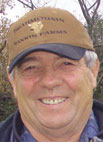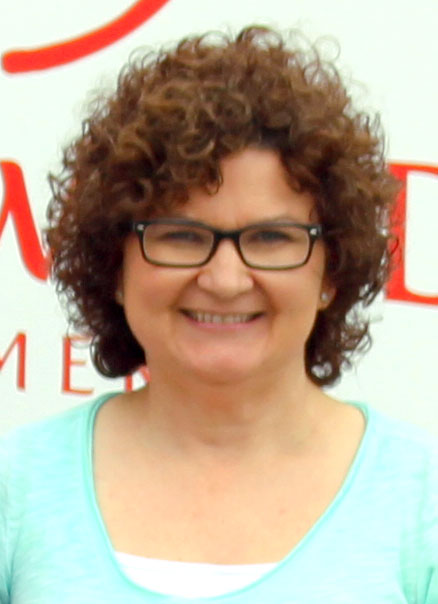
The Rankins found Brahmousin cattle at Farmfest. A producer out of Lamar was showcasing them. For years, Butch and Sandy had Registered Santa Gertrudis. But Butch consistently liked Brahman-influence in a cattle herd. “We like the Brahman influence in cattle,” said Butch, adding, “In this part of the country we have more hot days than cold. With a Brahman influenced animal, I don’t have to have as quality of pasture or as quality of feed to still have gain. I do feed as quality of pasture and feed as I can, I’m saying you don’t have to have that to see gains of upwards to 40 lbs. per calf at weaning time over other breeds.”
Butch Rankin has raised cattle all his life, and his heart is now solely for his Brahmousin cattle. A Limousin, Brahman cross, this breed is new to the cattle industry, only around 30 years old. “My dad was so proud of his Angus cattle,” Sandy smiled, “but, we just can’t seem to get along with them.”
European breeds will peak and fall through the year, but his Brahmousin just do better, regardless of the weather, Butch said. “Limousin are a cold country cow, and Brahman are known to take the heat more, and be more insect resistant,” Butch said of Brahmousin.
Butch knows his cattle will pass muster, but he likes to test them to prove their worth. “We sell feeder calves, and we send bunches to MU’s feeder program,” he said. “We average 65 to 67 percent cut out. No other breed will come close to that,” he said, firmly.
Now Butch also sends his cattle to OSU for steer feed outs. He’s continually amazed at the high cut out of his Brahmousin.
Butch and Sandy run 160 head of commercial and registered cattle. “Brahmousin is a fairly small association, and we’ve got about every bloodline,” he said.
The Brahmousin website tells the Brahmousin story, and the accomplishment of a Brahmousin animal. “The first Brahmousin cattle to be registered belonged to Daryl Wiggins in Marble Falls, Texas. A multiple embryo transfer from a French-imported Limousin dam, Gloria, during the late 1970s resulted in six heifers and three bull calves which formed the Limousin base. The stock was then cross bred to Brahman cattle achieving an F-1 cross, and further crosses over a broader base led to the 5/8-3/8 purebred.”
Sandy noted that Brahmousin offer many quality traits, including calving ease. “Calves are slender, but grow fast,” she noted.
“Brahmans have a richer milk, and Brahmousins have exceptional mothering ability,” Butch added.
“There are black ones but the common color is red,” Sandy noted.
“As an association we’ve considered color restrictions, but we’re not there yet,” Butch said. “And, we’re breeding polled into Brahmousins. We hunted to find a polled Brahman bull.”
The Rankins calve in the spring and fall, for, as Butch noted, “a better chance of hitting the markets. And, we’re getting ready to do MFA’s program,” he added.
Butch does his hay a little untraditionally, going for quantity, not quality. “I cut hay in mid- to late June, when protein goes down to 10-14 percent. Then I supplement salt, mineral and cottonseed. It's cheaper to have the cows take the second cutting of hay off, by grazing it out. It's more cost-effective that way. Then, in the wintertime, I make up the difference by feeding cottonseed meal. The trace minerals are gone from our soil here anyway,” he said, noting he offers supplements with plenty of trace minerals to offset that imbalance.
Despite the great pest- and disease-resistance he feels Brahmousin have, Butch said he doesn’t skimp on vaccinations and deworming. But, he said, the simple fact of his animals' heat resistance, means parasites are less of a problem. “Mine aren’t grouped up in a pond or under a tree, they’re spread out, eating,” he said. Cattle being cramped together is a breeding ground for disease and makes pests, flies and other insects much worse. And as for pinkeye, Butch said he’s seen one case in eight years in his Brahmousins.
The Rankins are the guardians of Keith Stephenson, and Keith helps out a lot around the farm. The family also works with area FFA and 4-H youth for the kids to have show animals.
But their cattle are not just show cows. The Rankins want animals that perform. When Butch sells his cattle at a stockyard sale, he said he knows there is a prejudice against a cow with an ear. “But, the bottom line is I come home with more profit because my calves weigh, on average, 40 lbs. more than the other calves selling will. When I come home, I’m putting more in the bank. Bottom line,” Butch said.
Butch’s enthusiasm for the Brahmousin breed is tangible, and he is eager for others to hear about the breed, and buy in, as he has. “In a lot of associations, you have to start at the bottom as new breeders, and climb to the top. We’re still building,” he said, adding with certainty, “I think there’s a place for this breed in the American beef industry.”







